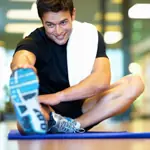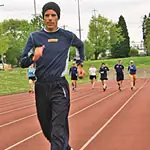Heads up
The head should be level, eyes looking forward, and the chin parallel to the ground. A protruding chin or tilting the head down to look at the ground are common mistakes.
If the head is allowed to tilt forward, excess strain is put on the neck and shoulders, which can lead to undue fatigue. Focus on looking forward to about 12 to 20 feet in front of you. If you need to look closer to where you are stepping, lower your eyes, not your whole head.
Arm swing
A walker's shoulders should be relaxed, not drawn up toward the ears. Arms should swing naturally with each step, and should be bent at the elbow at a 90-degree angle. This is important.
Straight arms on long walks lead to problems with swelling, tingling, and numbness of the fingers or hands. Bending them will not only eliminate this problem, it will also help you gain upper-body strength and tone your deltoids, biceps and triceps.
For many walkers, weight loss is a goal. By bending the arms, you will also burn 5 to 10 percent more calories. One more great reason to keep the arms bent and moving in an athletic motion is that you will immediately be able to pick up your pace for greater periods of time.
The bent arms should swing comfortable and naturally at about waist level. Your hands should be relaxed and loosely closed. Any excess tension in the arms or hands should be avoided--it wastes energy.
The elbows should be close to the torso, with the hands going no higher than the center of the chest on the forward swing, or past the back of the hip on the back swing. Again, more motion than this is wasted energy.
If you are new to this technique, you might initially find your arms getting fatigued. When practicing, keep your arms bent for 5 to 10 minutes, then lower them to recover. As soon as you feel rested, raise them again.
As part of your training, you might consider doing some upper-body weight work (not while you are walking) to increase your endurance. Specific exercises are suggested later.
Below the belt
Movement of the lower half of the body in this technique is the most difficult to describe, and for many walkers, the most difficult to achieve.
This is usually due to the inflexibility of the hips. Flexibility can be improved by consistently stretching the hip flexors and lower back, and for most people, simply doing the technique will help them considerably.
People new to this should go slow and practice. The time spent in learning and becoming comfortable with it will be rewarded with more efficient movement.
In your lower body, the walking technique begins by using the abdominal muscles and hip flexors to rotate the hip forward and lead the leg in its forward motion. As the leg swings forward and straightens, the body will land on the heel.
The ankle should be flexed, with toes pointed upward at about a 45-degree angle from the ground. The foot placement should be in front of the body, as if almost walking along a straight line. Keep in mind that the shortest distance between two points is a straight line. As the body's weight passes over the leading leg, the foot should roll forward and push off from the toes to begin the next step. A strong push will give you more momentum and power.
That's the basic technique. As you practice it and increase your hip flexibility, you will naturally develop a slightly longer stride.
A word of caution: It is counterproductive and potentially harmful to your back if you try to increase the length of your stride by taking longer unnatural steps. Speed and efficiency in walking are generated by hip flexibility and quicker, not longer, steps.
That's it! At first, this technique may seem complicated; but actually it is a natural motion where the whole body works in unison. Because of its low-impact nature, the head does not bob up and down. When done correctly, it is a very fluid movement that is easier on the body.
By using this time-tested and proven technique of walking, you can become more efficient in your stride and confident in your ability to achieve your goals.
Jo Ann Taylor is the co-founder and owner of The Walking Connection, one of the most highly rated walking, hiking and lifestyle related Web sites on the Internet with registered members in more than 40 countries. As a competitive racewalker, Jo Ann was a top 5 overall finisher in the Portland Marathon and led teams in the Portland, Anchorage, Catalina and Maui Marathons. As a sought-after lifestyle motivational speaker and fitness walking instructor, she has positively influenced the lives of thousands of people. As the Active Adventure Tour Director for her company, Jo Ann leads walking and hiking trips to destinations around the world.
- 2
- of
- 2





Discuss This Article